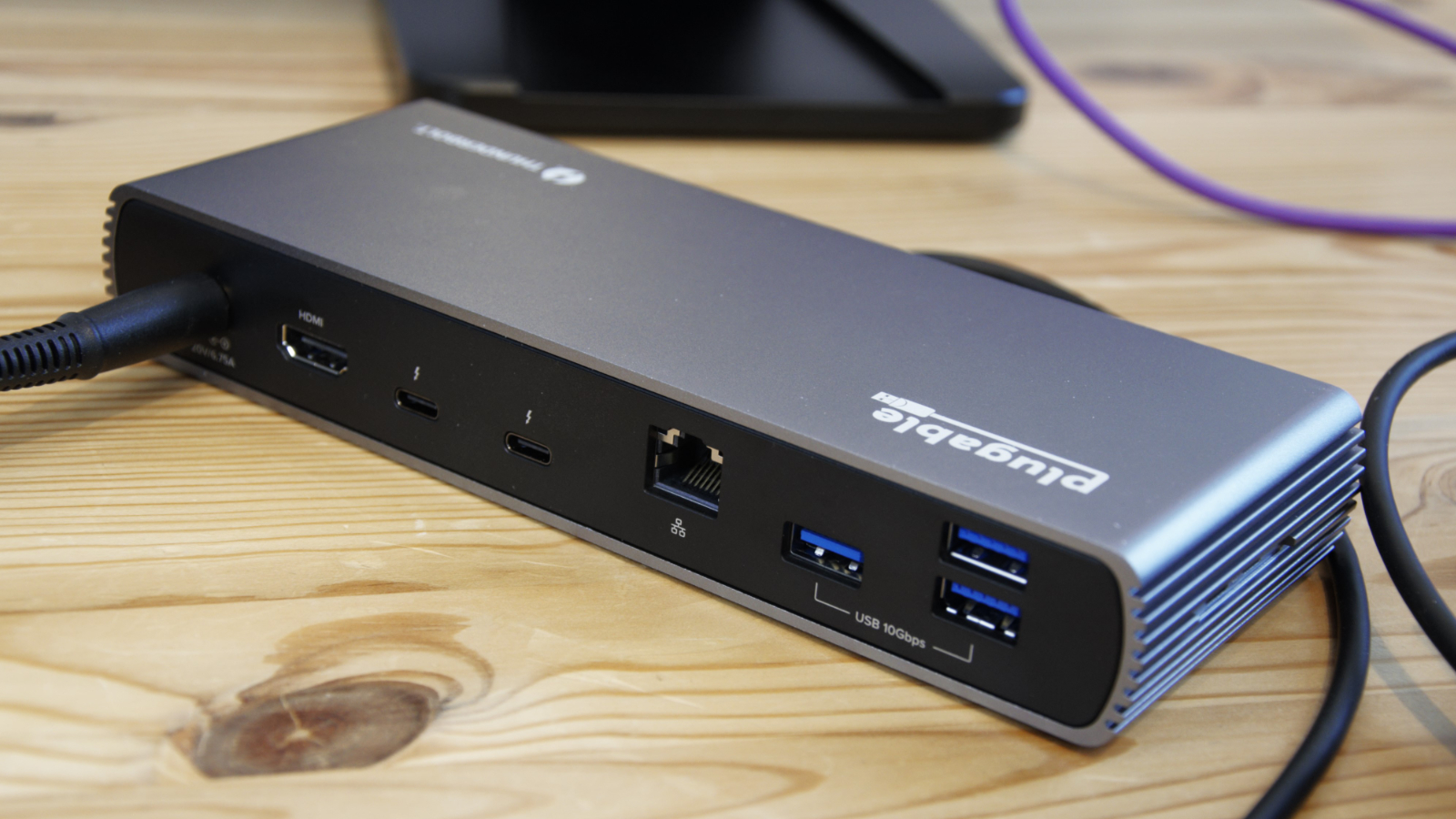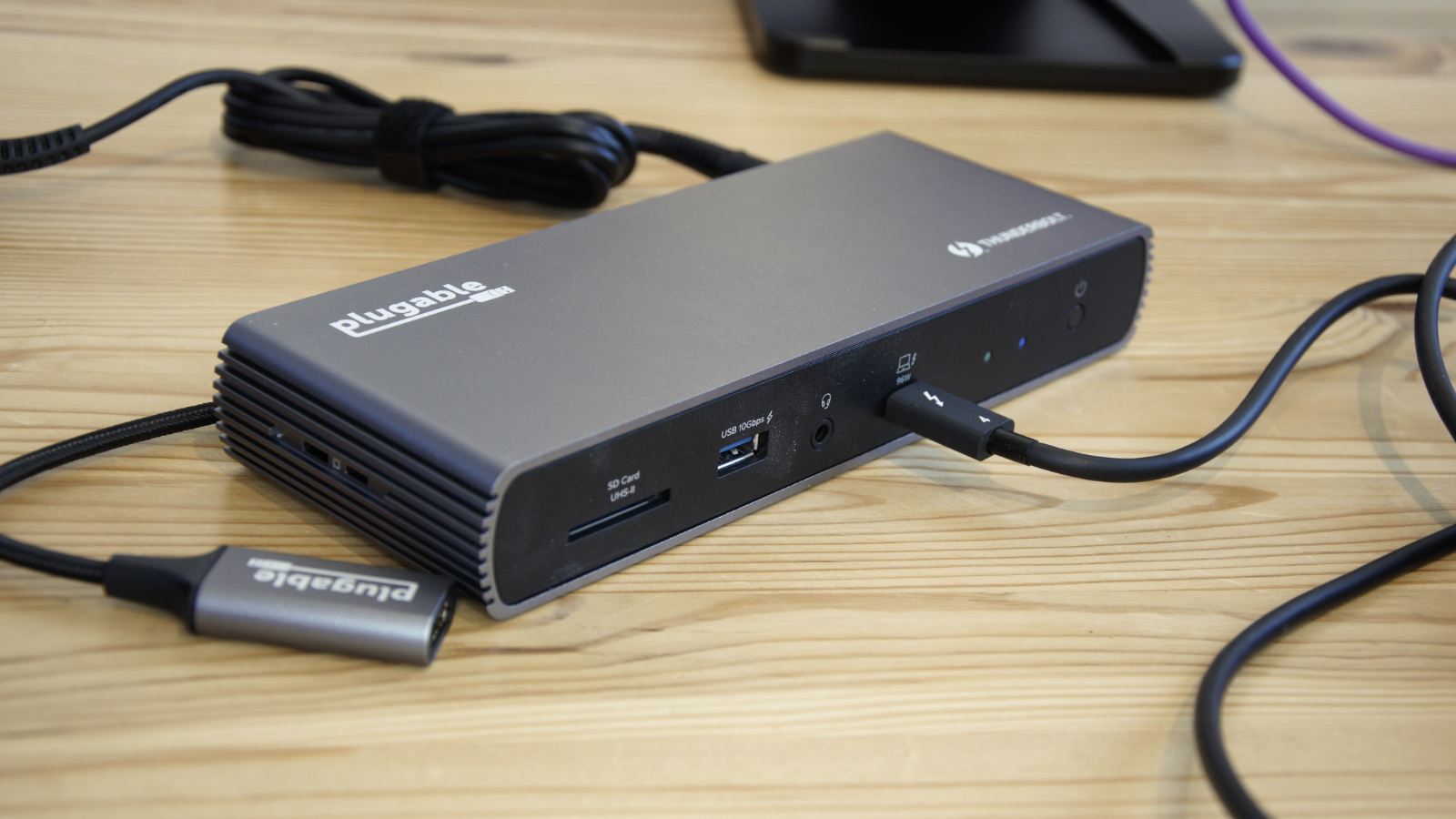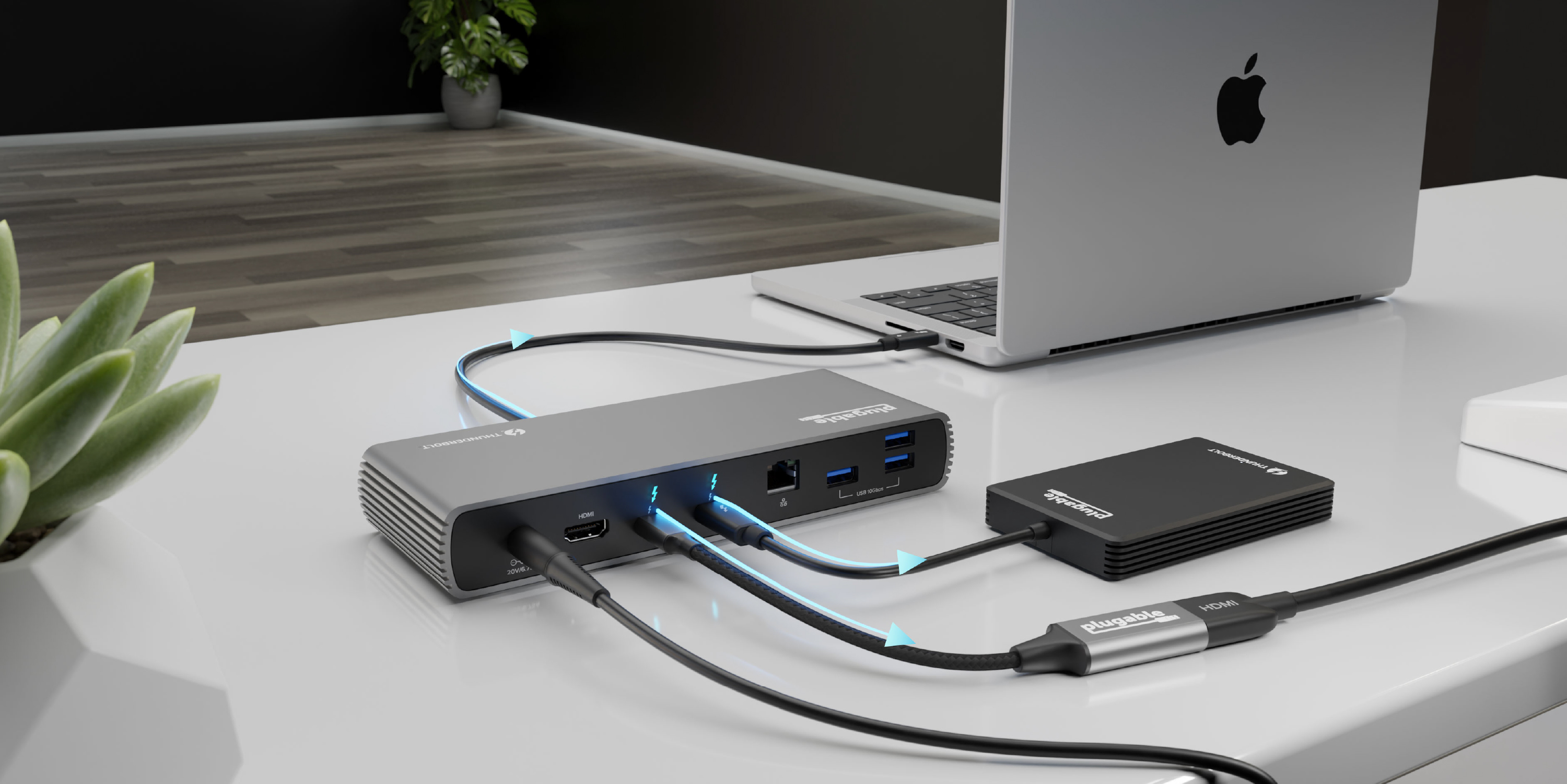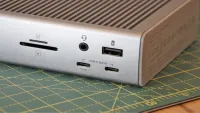TechRadar Verdict
It ticks almost every box for a Thunderbolt/USB 4.0 dock. Made to last, comes with a Thunderbolt to display adapter, 96W charging and bags of USB ports. It’s not cheap, but you undoubtedly get what you pay for with this product.
Pros
- +
Sturdy
- +
HDMI and DisplayPort output with adapter
- +
96W charging
- +
Two Thunderbolt downlinks
Cons
- -
Not cheap
- -
Front-facing host port
Why you can trust TechRadar
Plugable Thunderbolt 4 Dock: 30-second review
The current crop of Thunderbolt docking stations is mainly built around Intel’s earlier Titan Ridge chipset, a solution that makes delivering some features challenging since it is only Thunderbolt 3 spec.
But, the Plugable TBT4-UDX1 uses Goshen Ridge, the Thunderbolt 4 chipset, with many enhancements.
We’ve seen cheaper options with a single Thunderbolt downlink port, and even some with none, but the first thing that stands out with the Plugable TBT4-UDX1, to give it the official title, is that it has three Thunderbolt ports, including the host connection.
That’s a distinct advantage for users of Thunderbolt peripherals, but it also provides the flexibility to drive two monitors from this one dock using a Thunderbolt to DisplayPort adapter that is Plugable-branded and included in the box.
Given that some dock makers appear to resent providing a Thunderbolt cable, this is a nice feature that increases the flexibility of this solution without any additional purchases.
As with most Plugable products, the TBT4-UDX1 is built tough with a solid metal exterior, and security slots at one end prevent it from becoming an obvious candidate for redistribution.
There are docks with more ports, but the selection chosen by Plugable makes the most sense for most customers. These include plenty of USB-A ports and these are all of the USB 3.2 Gen 2 variety.
Sign up to the TechRadar Pro newsletter to get all the top news, opinion, features and guidance your business needs to succeed!
It also sports an SD card reader, a 2.5GbE LAN port, an audio jack, a HDMI port and two Thunderbolt downlink ports.
Charging on the host port is 100W with 96W certified, allowing this dock to easily handle even demanding ultrabooks.
If this product has a problem for some customers, it might be the price. You can get Thunderbolt docks for less money, but they are not built to these standards and, typically, not with this specification.
Plugable Thunderbolt 4 Dock: Price and availability

- How much does it cost? $290/£270
- When is it out? It is starting to be available now
- Where can you get it? Direct from Plugable Technologies or through online retailers like Amazon.
We’ve seen plenty of dock makers that charge incredibly high prices directly from their online store only to see the product elsewhere for substantially less. Thankfully, Plugable Technologies aren’t playing those games, and the price directly from them is much the same as you will pay on Amazon or wherever you shop.
At close to $300, this is far from the cheapest Thunderbolt dock available, but it is far from the most expensive, and for this specification, it seems reasonable.
- Value: 4 / 5
Plugable Thunderbolt 4 Dock: Specs
| Compatibility | TB4, TB3, USB 4.0, USB-C |
| Number of Ports | 11 |
| Ports | 1x TB4 upstream, 2x TB4 downstream, 4x USB 3.2 Gen 2 Type-A, 1x HDMI 2.0a, 1x universal audio combo jack, 1x 2.5GbE RJ45 Ethernet port, UHS-II SD card reader slot |
| Downstream power | 15W Thunderbolt |
| Upstream power | 100W Thunderbolt (96W certified) |
| Size | 200 x 75 x 30mm (W x D x H) |
| Weight | ? 443g |
| Accessories | Adapter 130W 20V 6.75A |
Plugable Thunderbolt 4 Dock: Design

- Sturdy construction
- Front-facing host port
Plugable went with the tried and tested approach of using an extruded aluminium tube as the structural component. In this design, the thickness of the metal provides significant rigidity and protection to the delicate electronics inside. The end plates are plastic, but the enclosure is well protected from having heavy objects land on it when it is on a desktop.
The external form also provides an effective means to radiate heat, and as there are no ventilation holes at all, that’s probably a good thing.
Thunderbolt docks tend towards similar designs where the front face has a small collection of ports that owners are likely to interface with on a regular basis, and those they use less are relegated to the back.
One bugbear for some customers is having the host port on the front. This preference is because those users typically disconnect this from their laptop at the machine and, therefore, would prefer it on the rear to leave things less cluttered.
It’s on the front here, but as the 1M long cable that Plugable includes will invariably need to come forward from the dock to connect, this isn’t a huge problem for this reviewer.
Other front-facing ports include the audio jack, a single USB 3.2 Gen 2 Type-A port (with 15A 7.5W charging) and the card reader.
All the other ports are on the rear, and the only other external features are the two security slots on the right-hand side.
In short, the Plugable TBT4-UDX1 isn’t as elegant as the Belkin Thunderbolt 4 Pro Dock. It could be accused of having slightly over-engineered construction, providing some confidence that it will last longer in deployment than cheaper options.

- Design: 4 / 5
Plugable Thunderbolt 4 Dock: Features
- 11 ports
- Display limitations
- 100W charging
This dock uses the latest Goshen Ridge chipset from Intel, which provides some advantages over the previous Alpine Ridge and Titan Ridge silicon. Cheaper docks use Thunderbolt 3 chipsets that will work with Thunderbolt 4, but these can’t exploit all the enhancements that Goshen Ridge silicon introduced.
The important difference is that where Thunderbolt 3 could, in theory, allocate the full 40Gbps bandwidth to a single device, the Goshen Ridge silicon can share that between three devices. That might sound like a disadvantage, but being able to share in this way makes for a more seamless experience.
In the Plugable TBT4-UDX1, a single 40Gbps PCIe Gen 3 bandwidth uplink connects the host to the dock, and depending on which of the ten ports are in use, the bandwidth is divided up between them.
With so many ports and only one TB4 connection, there is an oversubscription on bandwidth since each of the two TB downlinks can, in theory, run at 40Gbps, and all the USB-A ports are 10Gbps spec. This is normal, but most dock users realise that they can’t plug something into every port and get the maximum performance.
For those curious, if the dock is connected to a Thunderbolt 4 port, then both downlinks run as Thunderbolt 3. But if the uplink is only Thunderbolt 3, then one port will be set as being Thunderbolt 3 and the other USB-C.
Potentially, the most significant bandwidth consumption is for the video sub-system since supporting two 4K video streams at 60fps requires plenty of data.
I’ve seen other reviewers complain about HDMI 2.0b and how it doesn’t support higher refresh rates than 60Hz. That’s true, and you can’t connect a 120Hz or 144Hz monitor to the dock and get those refresh rates. It is possible to get those rates directly by connecting a Thunderbolt port from some computers, but in general, this isn’t something docks support.
Equally, it is possible to get 8K monitor support if the display has dual inputs. But as most laptops use integrated GPUs that don’t have the performance to drive 8K or dual 4K, being able to do this and the practical experience might be at odds.

Alongside the limitations of connecting monitors through docks, like all Thunderbolt docks, this one also has issues with early Apple MacBook M1 and M2 models where only one display is supported. This is a well-documented issue that was caused by Apple, and all docks have issues with some older Apple hardware.
The final technology subject is charging, and this dock promises 96W charging to the connected host. However, if you use the downstream ports, say for an external SSD, and it uses the 15W of power available on those ports, it will downgrade the charging power by 15W. This is something most docks do, but customers should be aware if they have a laptop that charges slowly when in use.
For features, the Plugable TBT4-UDX1 is about as good as it gets for Thunderbolt docks, or at least until the new Thunderbolt 5 chipset is complete and appears.
- Features: 4 / 5

Plugable Thunderbolt 4 Dock: Verdict
Unless you specifically want a dock with HDMI 2.1, the Plugable TBT4-UDX1 ticks all the boxes for functionality and flexibility.
Including a Thunderbolt to DisplayPort adapter ensures that dual displays can be driven, and for those with integrated graphics, that’s more than enough outputs.
All docks navigate a fine line between what they promise to do and what they actually deliver, but the implementation in this design does its best with what bandwidth is available when shared between ten ports.
For those who need a reliable and robust dock, the Plugable TBT4-UDX1 is a serious contender and easily worth the asking price.
Plugable Thunderbolt 4 Dock: Report card
| Value | It's not cheap, but the specification more than justifies the price. | 4 / 5 |
| Design | Unspectacular but extremely functional design. | 4 / 5 |
| Features | The killer feature of this dock is the two downstream TB ports, but it also has excellent USB support. | 4 / 5 |
| Total | Great specification and build quality. Caldigit offers more ports on the TS4, but this dock is less about showboating. | 4.5 / 5 |
Should you buy a Plugable Thunderbolt 4 Dock?

Buy it if...
You need a Thunderbolt workhorse
The TBT4-UDX1 is suitable for both those who want to connect USB peripherals and also Thunderbolt devices. The sturdy construction and simple form factor deliver a solution that should give many years of good service.
Multi-protocol is a requirement
Ideally, this is for a laptop or desktop system with Thunderbolt 4. But it will work well with Thunderbolt 3 and USB 4 if those are the options.
Don't buy it if...
You only have USB-C
While it will work in a limited fashion, a single USB-C port doesn’t have enough bandwidth to use many ports on this dock at the same time. If you only have USB-C, then a cheaper dock meant specifically for that technology might be a better choice.
You have an older MacBook M1
It's not a Plugable Technologies issue but an Apple one. These docks don’t work well with the original Apple MacBook M1 machines that use USB-C and not Thunderbolt. It might be worth researching this issue before investing.
Also consider
OWC Thunderbolt Dock
A cheap but still high-quality dock from OWC, this design has eleven ports and offers 90W charging.
What it lacks is a dedicated monitor port, but adapters for HDMI or Display port from Thunderbolt are available at extra cost.
Check out our OWC Thunderbolt Dock review
CalDigit Thunderbolt Station 4
The CalDigit Thunderbolt Station 4, or TS4 as it is also known, is a full-featured Thunderbolt dock that works with Thunderbolt 4/3 and USB-C.
It is not designed to be a portable dock but specifically to support a laptop user who comes to the office and wants a single cable connection to the network and a host of peripherals. To that objective, it has no less than 18 ports and can deliver up to 98W for charging a connected system.
Check out our CalDigit Thunderbolt Station 4 (TS4) review
Mark is an expert on 3D printers, drones and phones. He also covers storage, including SSDs, NAS drives and portable hard drives. He started writing in 1986 and has contributed to MicroMart, PC Format, 3D World, among others.



